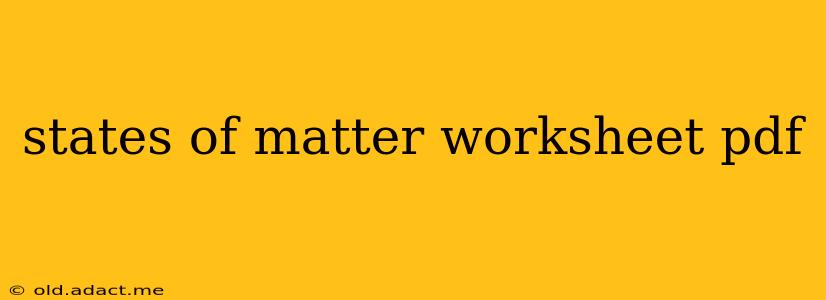States of Matter Worksheet: A Comprehensive Guide for Students
This worksheet explores the fascinating world of matter and its different states – solid, liquid, and gas. We'll delve into the properties of each state, examine phase changes, and explore real-world examples to solidify your understanding. This isn't just a worksheet; it's a journey into the fundamental building blocks of our universe!
What are the three main states of matter?
The three main states of matter are solid, liquid, and gas. Each state is defined by the arrangement and movement of its particles (atoms or molecules).
1. Solids:
Solids have a fixed shape and volume. Their particles are tightly packed together in a regular, ordered arrangement, held in place by strong intermolecular forces. This gives them a rigid structure and resistance to changes in shape.
Examples: Ice, wood, rock, metal.
2. Liquids:
Liquids have a fixed volume but a variable shape. Their particles are close together but not rigidly held in place. They can move and slide past each other, allowing the liquid to take the shape of its container.
Examples: Water, oil, juice, milk.
3. Gases:
Gases have variable shape and volume. Their particles are far apart and move freely and randomly, with weak intermolecular forces. They are easily compressed and expand to fill their containers.
Examples: Air, oxygen, helium, carbon dioxide.
What are some other states of matter?
While solid, liquid, and gas are the most common states, other states exist under extreme conditions:
- Plasma: A superheated state of matter where electrons are stripped from atoms, forming an electrically conductive mixture of ions and electrons. Found in stars and lightning.
- Bose-Einstein Condensate: A state of matter formed at extremely low temperatures where atoms behave as a single entity.
What are phase changes?
Phase changes are transitions between different states of matter. They involve the absorption or release of energy.
- Melting: Solid to liquid (ice to water)
- Freezing: Liquid to solid (water to ice)
- Evaporation: Liquid to gas (water to vapor)
- Condensation: Gas to liquid (vapor to water)
- Sublimation: Solid to gas (dry ice to carbon dioxide gas)
- Deposition: Gas to solid (frost formation)
How do the properties of solids, liquids, and gases relate to their particle arrangements?
The properties of each state directly result from how its particles are arranged and move. Solids' rigid structure comes from tightly packed, immobile particles. Liquids' ability to flow is due to particles that can move past each other. Gases' compressibility and expansion result from particles being far apart and moving freely.
Can you give examples of everyday phase changes?
Plenty! Boiling water (liquid to gas), ice melting (solid to liquid), dew forming on grass (gas to liquid), and snow sublimating on a sunny day (solid to gas) are all common examples.
What is the difference between evaporation and boiling?
Both are liquid-to-gas transitions, but they differ in how they occur. Evaporation happens at the surface of a liquid at any temperature, while boiling occurs throughout the liquid at a specific temperature (the boiling point).
This worksheet provides a foundation for understanding the states of matter. Further exploration into the microscopic behavior of particles and the forces that govern phase transitions will deepen your understanding of this fundamental concept in science. Remember to consult your textbook or other reliable resources for more detailed information and diagrams.
